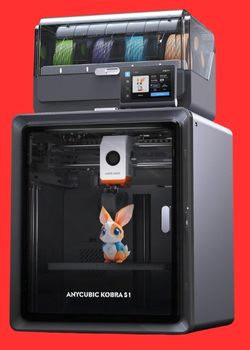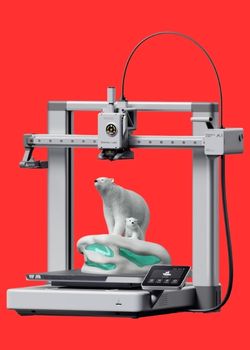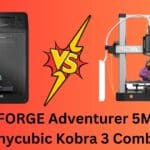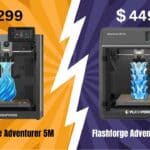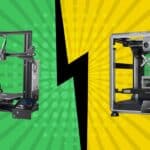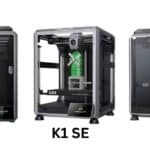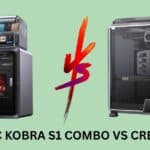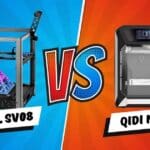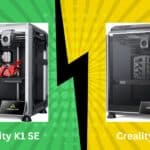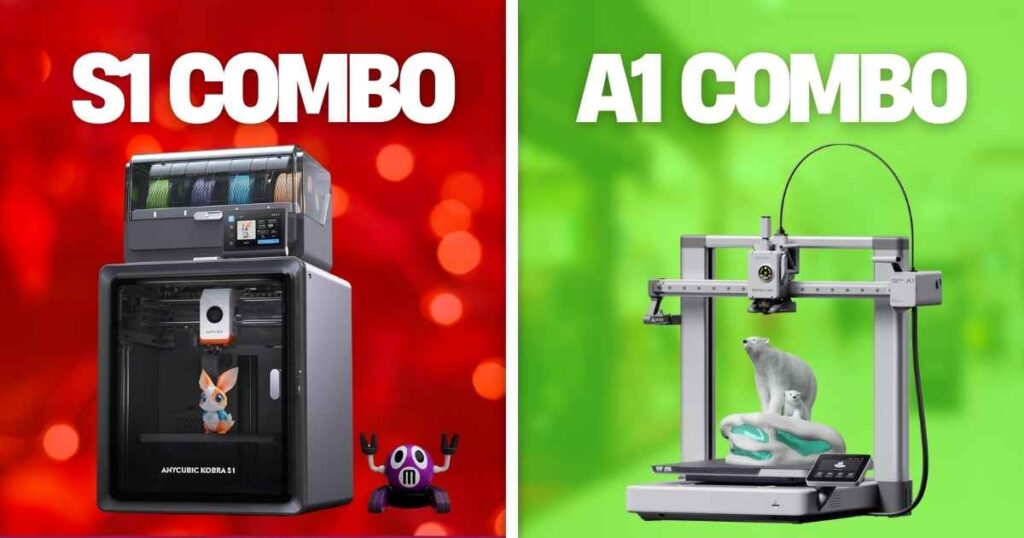
The Anycubic Kobra S1 Combo ($549.99) offers vibrant 8-color printing and high-temp filament support, ideal for budget-conscious creators. The Bambu Lab A1 Combo ($629.00) excels in user-friendly 4-color printing, perfect for beginners.
Quick Summary Highlights
- Anycubic Kobra S1 Combo: Affordable at $549.99, up to 8 colors, 600mm/s speed, fully enclosed.
- Bambu Lab A1 Combo: Beginner-friendly at $629.00, 4-color AMS Lite, 500mm/s speed, auto-calibration.
- Both printers support PLA, PETG, TPU, ABS, ASA; Kobra S1 adds PA, PC.
- Kobra S1 scores 88/100; A1 Combo scores 86/100 based on our tests.
Affiliate Disclosure
We participate in Amazon affiliate programs, earning fees from qualifying purchases via links at no extra cost to you. It’s how we keep this blog rolling and my 3D printers buzzing with fresh filament for reviews like this one!
Multi-color 3D printing is transforming home decor in 2025, enabling enthusiasts to create vibrant 3D-printed vases, kitchen organizers, and intricate wall art with stunning detail. The Anycubic Kobra S1 Combo and Bambu Lab A1 Combo are two standout multi-color 3D printers designed for high-speed, vibrant printing. Priced at $549.99 and $629.00 respectively, both offer advanced features like auto-leveling, high-temperature hotends, and intelligent ecosystems, but cater to slightly different needs. Whether you’re a beginner crafting your first home decor piece or an advanced user tackling complex multi-color projects, our in-depth Anycubic Kobra S1 Combo vs Bambu Lab A1 Combo comparison will help you choose the best printer for your creative vision.
We’ve rigorously tested both printers, analyzing their performance, ease of use, and value for money, drawing on user reviews and technical specifications. From the Kobra S1’s 8-color capability to the A1 Combo’s seamless setup, we’ll break down their strengths and weaknesses to find the perfect fit for your home decor projects. For more on how these compare to other Anycubic models, check out our Kobra S1 Combo vs. Kobra 3 Combo review.
Comparison Table
| Feature | 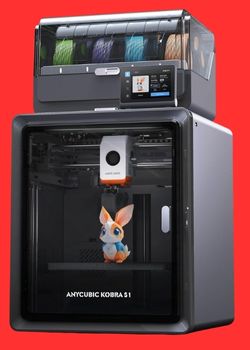 Anycubic Kobra S1 Combo Anycubic Kobra S1 Combo |  Bambu Lab A1 Combo Bambu Lab A1 Combo |
|---|---|---|
| Price | $549.99 (27% savings) | $629.00 (26% savings) |
| Build Volume | 250 x 250 x 250 mm | 256 x 256 x 256 mm |
| Print Speed | 600 mm/s (max), 300 mm/s (recommended) | 500 mm/s (max), 300 mm/s (recommended) |
| Max Nozzle Temp | 320°C | 300°C |
| Max Bed Temp | 120°C | 100°C |
| Auto-Leveling | LeviQ3.0 auto-leveling with Z-offset | Full-auto calibration with Z-offset |
| Enclosure | Fully enclosed CoreXY | Optional enclosure (not included) |
| Software Flexibility | Anycubic Slicer Next, supports Orca with Rinkhal | Bambu Studio, Orca Slicer |
| Filament Compatibility | PLA, PETG, TPU (single-color), ABS, ASA, PA, PC | PLA, PETG, TPU, ABS, ASA |
| Noise Level | 44 dB (quiet mode) | ≤48 dB |
| Additional Features | Built-in camera, ACE Pro filament drying | AMS Lite, 1-Clip nozzle swap |
Anycubic Kobra S1 Combo vs Bambu Lab A1 Combo: Detailed Comparison
Price and Value for Money
The Anycubic Kobra S1 Combo, priced at $549.99 with a 27% savings, offers exceptional value for its multi-color capabilities. The included ACE Pro unit supports 4-color printing, with the option to upgrade to 8 colors by purchasing a second unit, making it a cost-effective choice for vibrant home decor projects like multi-colored vases or layered organizers. Reviewer Daniel Vasquez called it “a steal” for its price and functionality, emphasizing its appeal for beginners.
The Bambu Lab A1 Combo, at $629.00 with 26% savings, commands a slight premium for its reliable 4-color AMS Lite system and user-friendly design. While both printers deliver strong value, the Kobra S1’s lower price and fully enclosed design make it the better deal for budget-conscious creators working with high-temperature filaments like ABS for outdoor decor. For more budget-friendly options, see our best multi-color 3D printers of 2025.
For home decor enthusiasts, the Kobra S1’s affordability allows investment in additional filaments or accessories, while the A1 Combo’s higher price is justified by its seamless setup, as reviewer Rubixcube noted its “flawless” performance out of the box after just 47 minutes of setup.
Multi-Color Printing Capabilities
The Kobra S1 Combo’s ACE Pro system is its flagship feature, enabling 4-color printing with one unit and up to 8 colors with a second unit (sold separately). This is a game-changer for home decor, allowing intricate designs like gradient-patterned vases or multi-hued kitchen organizers. However, user Bentley H. reported significant issues, including “broken” or “abnormal filament” errors and buffer jams that halted 8-color prints, describing the ACE Pro as “garbage” until revamped. Matt and Kelley suggested leaving the ACE Pro lid open for long prints as a temporary fix, but these issues may deter beginners.
In contrast, the A1 Combo’s AMS Lite system delivers reliable 4-color printing, praised by reviewer Customer for its ease and vibrant results. For home decor projects requiring simpler color schemes (e.g., 4-color wall art), the A1 Combo’s consistency is a safer bet, while the Kobra S1’s 8-color potential appeals to advanced users willing to troubleshoot for complex designs.
Print Speed and Quality
High-speed printing is critical for producing home decor items efficiently, and both printers deliver. The Kobra S1 Combo reaches 600mm/s (recommended 300mm/s) with resonance compensation and flow correction, ensuring smooth, detailed prints for items like vases or organizers. Reviewer David La Belle praised its “amazing” print quality when using Orca Slicer with Rinkhal.
The A1 Combo, with 500mm/s (recommended 300mm/s) and 10,000 mm/s² acceleration, uses active flow rate compensation for flawless results, as Rubixcube demonstrated with a “full-size chocobo head” printed perfectly. Both printers excel in quality, but the Kobra S1’s slight speed advantage and enclosed design enhance its ability to handle temperature-sensitive filaments like ABS, ideal for durable outdoor decor pieces like garden sculptures. For filament selection tips, check our filament compatibility guide.
For example, printing a 200mm-tall vase at 300mm/s takes about 4-5 hours on either printer, but the Kobra S1’s enclosure ensures better consistency with ABS, while the A1 Combo’s flow compensation minimizes layer imperfections in PLA or PETG prints.
Build Volume
The Kobra S1 Combo offers a 250x250x250mm build volume, while the A1 Combo provides a slightly larger 256x256x256mm. For most home decor projects—such as medium-sized vases, organizers, or wall art—this 6mm difference is minor. However, the A1 Combo’s extra space allows for slightly larger prints, like oversized lampshades or multi-piece decor sets, which may appeal to users creating statement pieces. Both printers are well-suited for typical decor projects, but the A1 Combo’s marginal advantage could matter for specific large-scale designs.
Ease of Use
The A1 Combo is designed for beginners, with full-auto calibration and a simplified touchscreen interface. Reviewer Barbara described setup as “like nothing,” and Rubixcube completed bed leveling and first prints in 47 minutes. This makes it ideal for novices crafting their first organizers or vases. The Kobra S1’s LeviQ3.0 auto-leveling is intuitive, but reviewer bwingler encountered “11511 errors” and bed adhesion issues, requiring a glue stick and hours of troubleshooting. While senior reviewer Larry Gibson set up the Kobra S1 effortlessly, the ACE Pro’s issues can complicate the experience for less experienced users, making the A1 Combo the easier choice for beginners. For maintenance tips to avoid such issues, see our 3D printer maintenance guide.
Enclosure and Versatility
The Kobra S1’s fully enclosed CoreXY design is a significant advantage for printing high-temperature filaments like ABS and ASA, which require stable temperatures for durable outdoor decor like garden sculptures or weather-resistant planters. Its 320°C hotend and 120°C bed support a wide range of filaments (PLA, PETG, TPU, ABS, ASA, PA, PC), enhancing versatility.
The A1 Combo’s open-frame design (optional enclosure not included) and 300°C hotend/100°C bed limit its ability to handle advanced filaments like PC or high-temp ABS consistently. Reviewer Customer improvised a DIY humidity tent for the A1 Combo’s AMS Lite, highlighting the need for an enclosure in humid environments (e.g., 48% humidity reduced to 29% overnight). The Kobra S1’s enclosure and filament drying make it more versatile for diverse home decor projects. For more on filament drying, explore our top filament dryers guide.
Software and Support
The Kobra S1’s Anycubic Slicer Next includes filament parameter sets but is criticized for lacking flexibility, with David La Belle recommending Orca Slicer with Rinkhal for “flawless” results. The Anycubic App offers remote control and time-lapse recording, and Makeronline provides free model resources, but tech support struggles with ACE Pro issues, as Bentley H. noted delays in replacement parts. The A1 Combo’s Bambu Studio is intuitive and supports Orca Slicer, but reviewer Rescue Inc. criticized its Amazon-based support as “no help.” Both printers benefit from community resources, but the A1 Combo’s software is more beginner-friendly, while the Kobra S1’s support issues may frustrate users.
Additional Features
The Kobra S1’s built-in camera enables real-time monitoring, ideal for long prints of decor items like intricate vases, and its 44dB quiet mode minimizes disturbance in home settings. The ACE Pro’s dual PTC heating and 360° hot air circulation drying prevent moisture issues, crucial for ABS prints. The A1 Combo’s 1-Clip nozzle swap simplifies maintenance, and its ≤48dB noise level is quiet but slightly louder than the Kobra S1. The AMS Lite lacks drying, requiring workarounds like Customer’s DIY tent. For home decor, the Kobra S1’s camera and drying provide a professional edge, while the A1 Combo’s nozzle swap enhances maintenance ease.
Frequently Asked Questions
Which 3D printer is better for multi-color printing?
The Anycubic Kobra S1 Combo supports up to 8 colors with dual ACE Pro units, making it ideal for vibrant, complex decor projects. The Bambu Lab A1 Combo offers 4-color printing with AMS Lite, better for simpler multi-color designs.
Is the Anycubic Kobra S1 Combo good for beginners?
While the Kobra S1 Combo is user-friendly with LeviQ3.0 auto-leveling, its setup may require troubleshooting, making it slightly less beginner-friendly than the Bambu Lab A1 Combo’s full-auto calibration.
Can these printers handle high-temperature filaments?
The Kobra S1 Combo’s 320°C hotend supports high-temp filaments like PA and PC, while the A1 Combo’s 300°C hotend is limited to PLA, PETG, TPU, ABS, and ASA.
Do these printers come with an enclosure?
The Kobra S1 Combo has a fully enclosed CoreXY design, ideal for temperature-sensitive filaments. The A1 Combo lacks an enclosure, though an optional one can be purchased separately.
Conclusion: The Winner Is…
Anycubic Kobra S1 Combo
Pros
- Affordable at $549.99 with 27% savings
- Up to 8-color printing with dual ACE Pro units
- 600mm/s high-speed printing for quick decor projects
- 320°C hotend supports PLA, ABS, ASA, PETG, TPU, PA, PC
- Quiet 44dB operation with built-in camera and filament drying
Cons
- ACE Pro unit prone to filament feeding issues
- Anycubic Slicer software lacks flexibility
- Setup may require troubleshooting for beginners
Bambu Lab A1 Combo
Pros
- Seamless 4-color printing with AMS Lite
- 500mm/s speed with 10,000 mm/s² acceleration
- Full-auto calibration for effortless setup
- Active flow rate compensation for smooth prints
- Supports PLA, PETG, TPU, ABS, ASA
Cons
- No enclosure, noisier at 48dB
- Limited customer support through Amazon
- 300°C hotend restricts high-temp filaments

